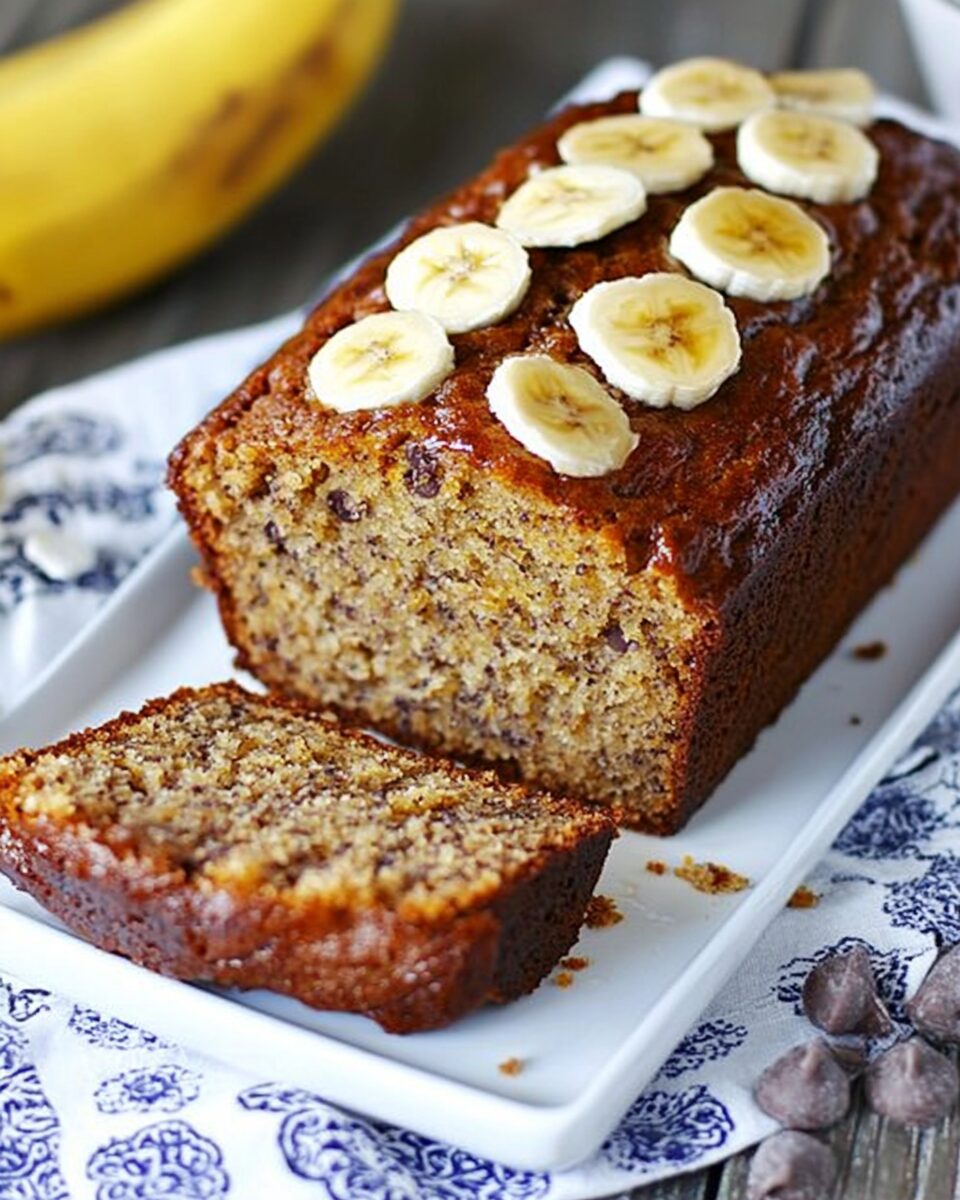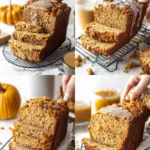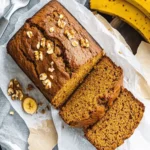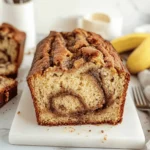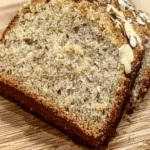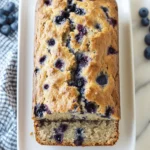A moist, naturally sweetened banana bread that’s packed with wholesome ingredients and full of rich banana flavor. This healthier twist on a classic favorite is perfect for breakfast, snacks, or dessert, offering a satisfying treat with less guilt.
FULL RECIPE
Ingredients
- 3 ripe bananas, mashed
- 2 large eggs
- 1/4 cup honey or maple syrup
- 1/4 cup plain Greek yogurt
- 1/4 cup coconut oil, melted
- 1 teaspoon vanilla extract
- 1 1/2 cups whole wheat flour
- 1 teaspoon baking soda
- 1/2 teaspoon ground cinnamon
- 1/4 teaspoon salt
- 1/2 cup chopped walnuts or dark chocolate chips (optional)
Directions
- Preheat oven to 350°F (175°C). Grease a 9×5-inch loaf pan or line with parchment paper.
- In a large bowl, whisk together the mashed bananas, eggs, honey (or syrup), yogurt, coconut oil, and vanilla.
- In a separate bowl, mix the flour, baking soda, cinnamon, and salt.
- Gradually add the dry ingredients to the wet ingredients, stirring until just combined.
- Fold in walnuts or chocolate chips if using.
- Pour the batter into the prepared loaf pan and spread evenly.
- Bake for 45–55 minutes or until a toothpick inserted into the center comes out clean.
- Allow to cool in the pan for 10 minutes, then transfer to a wire rack to cool completely.
- Slice and serve once fully cooled.
Nutritional Information
- Calories: 180
- Protein: 4g
- Carbohydrates: 25g
- Sugars: 10g
- Fat: 7g
- Fiber: 3g
- Saturated Fat: 3g
- Sodium: 180mg
Nutritional Benefits of Banana Bread
Banana bread made with whole wheat flour, natural sweeteners like honey or maple syrup, and healthy fats such as coconut oil offers significant nutritional advantages. It provides a good source of dietary fiber, which aids digestion and promotes a feeling of fullness. The bananas add natural sweetness along with essential vitamins like vitamin C and B6, as well as potassium, which supports heart and muscle health. Incorporating Greek yogurt contributes protein and probiotics, enhancing gut health.
Why Use Ripe Bananas?
Ripe bananas are sweeter and softer, making them ideal for baking. Their natural sugars reduce the need for added sweeteners, while their moisture content helps create a tender texture. Overripe bananas with brown spots contain higher sugar levels and intense flavor, perfect for banana bread.
Healthier Sweetening Alternatives
Using honey or maple syrup instead of refined sugar adds a subtle, natural sweetness and some trace minerals. These options have a lower glycemic index than white sugar, causing less of a spike in blood sugar levels, making the bread more suitable for those managing their sugar intake.
Benefits of Whole Wheat Flour
Whole wheat flour retains the bran and germ of the grain, providing more fiber, vitamins, and minerals than refined flour. It supports better digestion and provides sustained energy release. The slight nutty flavor complements the sweetness of the bananas and enhances the bread’s overall nutritional profile.
Role of Coconut Oil
Coconut oil is a healthy fat rich in medium-chain triglycerides (MCTs), which are metabolized differently from other fats and may provide quick energy. It also helps keep the bread moist and tender while adding a subtle tropical flavor.
Incorporating Greek Yogurt
Greek yogurt adds moisture and a slight tanginess to the banana bread. It is an excellent source of protein and calcium, supporting muscle and bone health. Additionally, the probiotics in yogurt can contribute to a healthy digestive system.
Baking Soda and Cinnamon: More Than Flavor
Baking soda acts as a leavening agent that helps the bread rise and become fluffy. Cinnamon adds warmth and depth of flavor while providing antioxidants and potential anti-inflammatory benefits, making the bread not just tasty but also healthier.
Optional Add-Ins and Their Benefits
Adding walnuts provides crunch and a boost of omega-3 fatty acids, which are essential for brain health and reducing inflammation. Dark chocolate chips add richness and antioxidants. Both ingredients elevate the flavor and nutritional value.
Tips for Perfect Texture
Avoid overmixing the batter to prevent a dense, tough loaf. The goal is to combine ingredients until just incorporated. The natural moisture from bananas and yogurt, combined with coconut oil, ensures a soft crumb.
Storage and Shelf Life
Store banana bread wrapped in plastic wrap or in an airtight container at room temperature for up to three days. Refrigeration extends freshness to about a week, while freezing allows storage for up to three months without losing flavor or texture.
Serving Suggestions
Banana bread is versatile and can be enjoyed on its own or with toppings such as nut butter, fresh fruit, or a light spread of cream cheese. It works well for breakfast, a midday snack, or a wholesome dessert.
Adapting for Dietary Restrictions
This recipe is naturally gluten-friendly if made with gluten-free flour blends instead of whole wheat. It is also easily adjusted for dairy-free diets by using plant-based yogurt alternatives. The use of eggs can be substituted with flax or chia egg replacers for vegan versions.
Cultural Popularity and Variations
Banana bread has become a global favorite due to its simple ingredients and comforting flavor. Different regions add their own twists, like coconut flakes in tropical areas or spices like nutmeg and cloves in others, showcasing its versatility.
Environmental Impact
Using ripe bananas that might otherwise be discarded reduces food waste, making banana bread a sustainable choice. Choosing organic and locally sourced ingredients can further lower the environmental footprint of this treat.
Common Mistakes to Avoid
One common error is baking banana bread at too high a temperature, which can cause the crust to brown too quickly while leaving the inside undercooked. Another is adding too many wet ingredients, resulting in a soggy loaf. Measuring ingredients accurately ensures the best results.
How to Tell When It’s Done
A clean toothpick or skewer inserted into the center of the bread indicates it’s fully baked when it comes out without wet batter. The loaf should also spring back slightly when pressed.
Healthier Snack Alternative
Compared to store-bought cakes and pastries, this banana bread is a healthier choice with less processed sugar and more fiber. It can satisfy sweet cravings while contributing beneficial nutrients, making it a smart snack for adults and kids alike.
Pairing with Beverages
Banana bread pairs wonderfully with coffee, tea, or a glass of milk. The warmth and richness of these drinks complement the bread’s sweet and spicy notes, enhancing the overall experience.
History and Origin
Banana bread became popular in the United States during the Great Depression when people sought ways to reduce waste by using overripe bananas. It has since evolved into a beloved recipe passed down through generations.
Conclusion
Healthy and tasty banana bread offers much more than just a delicious treat. By choosing wholesome ingredients, it provides a nourishing option that supports overall well-being while indulging the senses. Its adaptability allows for personalization to suit various dietary needs and preferences. Whether enjoyed fresh from the oven or as a snack throughout the week, this banana bread recipe brings comfort, nutrition, and satisfaction all in one slice.

